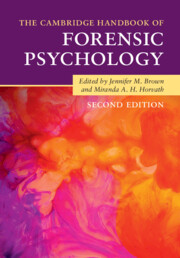Book contents
- The Cambridge Handbook of Forensic Psychology
- The Cambridge Handbook of Forensic Psychology
- Copyright page
- Dedication
- Contents
- Figures
- Tables
- Contributors
- Preface
- Forensic Psychology
- Part I Psychological Underpinnings
- Part II Psychology and Criminal Behaviour
- Part III Assessment
- 3.1 Credibility and Investigative Interviewing
- 3.2 Eyewitness Testimony
- 3.3 Psychopathic Personality Disorder
- 3.4 Forensic Mental Health Assessments
- 3.5 Intellectual Disabilities and Offending Behaviour
- 3.6 Head Injury and Offending
- 3.7 Parole Decision-Making
- 3.8 Risk and Dangerousness in Adults
- Part IV Interventions
- Part V Civil Proceedings
- Part VI Professional Practices
- Index
- References
3.1 - Credibility and Investigative Interviewing
from Part III - Assessment
Published online by Cambridge University Press: 02 December 2021
- The Cambridge Handbook of Forensic Psychology
- The Cambridge Handbook of Forensic Psychology
- Copyright page
- Dedication
- Contents
- Figures
- Tables
- Contributors
- Preface
- Forensic Psychology
- Part I Psychological Underpinnings
- Part II Psychology and Criminal Behaviour
- Part III Assessment
- 3.1 Credibility and Investigative Interviewing
- 3.2 Eyewitness Testimony
- 3.3 Psychopathic Personality Disorder
- 3.4 Forensic Mental Health Assessments
- 3.5 Intellectual Disabilities and Offending Behaviour
- 3.6 Head Injury and Offending
- 3.7 Parole Decision-Making
- 3.8 Risk and Dangerousness in Adults
- Part IV Interventions
- Part V Civil Proceedings
- Part VI Professional Practices
- Index
- References
Summary
Effective investigative interviewing is at the heart of any police investigation and thus is the root of achieving justice in society. This is because the key aims underpinning any investigation are to: (i) find out what happened, and if anything did happen, (ii) to discover who did what, and (iii) to collect evidence in a way that will be credible to decision-makers. In order to achieve this, investigators need to gather information whose source is usually a person (e.g., a witness, victim, suspect, complainant, first officer at the scene of a crime and so on). Thus, one of the most important tools in an investigator’s toolbox is the ability to interview. This chapter will examine the evidence base examining the most effective methods to interview and assess witness reliability within an investigative context.
- Type
- Chapter
- Information
- The Cambridge Handbook of Forensic Psychology , pp. 339 - 352Publisher: Cambridge University PressPrint publication year: 2021
References
- 1
- Cited by



